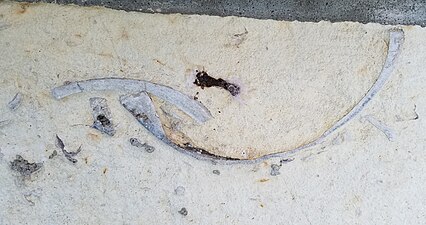| Cremnoceramus Temporal range: Turonian-Maastrichtian ~94–66 Ma PreꞒ Ꞓ O S D C P T J K Pg N | |
|---|---|

| |
| Cremnoceramus deformis in early Turonian Fort Hays limestone, showing characteristic wavy rugae. | |
| Scientific classification | |
| Domain: | Eukaryota |
| Kingdom: | Animalia |
| Phylum: | Mollusca |
| Class: | Bivalvia |
| Order: | Pteriida |
| Family: | †Inoceramidae |
| Genus: | †Cremnoceramus Cox, 1969 (posthumous) |
| Species | |
| |

Cremnoceramus ("cremno-" = kremnos : precipice or over hanging wall or bank; "ceramus" = keramos : clay pot) is an extinct genus of fossil marine pteriomorphian bivalves that superficially resembled the related winged pearly oysters of the extant genus Pteria. They lived from the Turonian to the Maastrichtian of the Late Cretaceous.
Description
Cremnoceramus were facultatively mobile, blind, suspension feeding bivalves with low-magnesium calcite shells. Inoceramids, like the Cremnoceramus in particular, had thick shells composed of particular "prisms" of calcite deposited perpendicular to the surface, and unweathered fossils commonly preserve the mother-of-pearl luster the shells had in life. Compared to the many examples of broad and flattened Inoceramidae, Cremnoceramus shells are rather "high-walled", deep bowl-shaped. The top shell is commonly encrusted with oysters.
Species
The following species are recognized:
- C. crassus
- C. deformis
- C. inconstans
- C. rotundatus
- C. waltersdorfensis
Biostratigraphic significance
The first appearance of the species Cremnoceramus rotundatus marks the beginning of the Coniacian stage.
Distribution
Fossils of the genus have been found in:
- Gosau Formation, Austria
- Cotinguiba Formation, Brazil
- Pointe-Noire, Congo-Brazzaville
- Jicin, the Czech Republic
- Arnager Limestone Formation, Denmark
- Craie de Villedieu Formation, France
- Germany
- Anaipadi Formation, India
- Tongobury, Madagascar
- Austin Group, Mexico
- Sant Corneli and El Zadorra Formation, Spain
- Lewes Nodular Chalk Formation, the United Kingdom
- Niobrara Formation, New Mexico, United States
Gallery
Note the oyster encrustation of the top shells:
-
 Horizontal section of articulated C. deformis (Fort Hays ls.)
Horizontal section of articulated C. deformis (Fort Hays ls.)
-
 Lateral section of articulated C. deformis (Fort Hays ls.)
Lateral section of articulated C. deformis (Fort Hays ls.)
-
 Lateral section of articulated C. deformis (Fort Hays ls.)
Lateral section of articulated C. deformis (Fort Hays ls.)
-
 Horizontal section of articulated C. deformis (Fort Hays ls.)
Horizontal section of articulated C. deformis (Fort Hays ls.)
References
- "Lower Turonian Euramerican Inoceramidae: A morphologic, taxonomic, and biostratigraphic overview". Faculty of Science, Vrije Universiteit Amsterdam. p. see Figure 3 for illustration of rugae. Retrieved 2020-12-29.
- Collum, Christofer J. (1998). "Taxonomy Biostratigraphy and Phylogeny of the Upper Cretaceous Bivalve Cremnoceramus (Inoceramidae) in the Western Interior of Canada and the United States". In Paul A. Johnston and James W. Haggart (ed.). Bivalves: An Eon of Evolution; Paleobilogical Studies Honoring Norman D. Newell. University of Calgary Press. pp. 119–142. Retrieved 2020-12-29.
- ^ "Cremnoceramus". Mindat.org. Retrieved 2020-12-29.
- Ludvigsen, Rolf; Beard, Graham (1997). West Coast Fossils: A Guide to the Ancient Life of Vancouver Island. Harbour Pub. pp. 102–103. ISBN 978-1-55017-179-2.
- "Cremnoceramus". Open Tree of Life. Retrieved 2020-12-29.
- Cremnoceramus at Fossilworks.org
| Taxon identifiers | |
|---|---|
| Cremnoceramus | |
This article about a Cretaceous animal is a stub. You can help Misplaced Pages by expanding it. |
This article about a prehistoric bivalve is a stub. You can help Misplaced Pages by expanding it. |
- Inoceramidae
- Prehistoric bivalve genera
- Index fossils
- Coniacian life
- Cretaceous Austria
- Fossils of Austria
- Cretaceous Brazil
- Fossils of Brazil
- Fossils of the Czech Republic
- Cretaceous Denmark
- Fossils of Denmark
- Cretaceous France
- Fossils of France
- Cretaceous Germany
- Fossils of Germany
- Cretaceous India
- Fossils of India
- Cretaceous Madagascar
- Fossils of Madagascar
- Cretaceous Mexico
- Fossils of Mexico
- Cretaceous Spain
- Fossils of Spain
- Cretaceous England
- Fossils of England
- Cretaceous geology of New Mexico
- Fossils of the United States
- Fossil taxa described in 1969
- Cretaceous animal stubs
- Prehistoric bivalve stubs